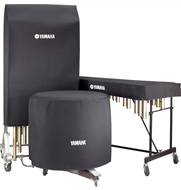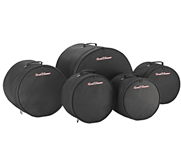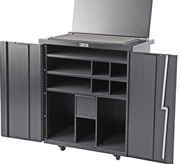If you’ve got a large percussion section, you may feel like there is a lot to keep track of, what with all the instruments, racks, stands, carts, carriers, sticks and heads—let alone the percussion students! The key to saving time, money and your sanity lies in being organized. Set up your percussion section in a precise way and incorporate organizing tips into your students’ routines. Purchase high quality instruments and accessories and then properly store and maintain all of your percussion assets. Following these basic rules will result in your students spending more time practicing and performing and less time searching for items and setting up.
What should your percussion section look like?
Depending on the size of your program, your percussion section will vary. You may or may not have budget for timpani or large mallet keyboards. You might have enough room in your space to leave everything set up all the time or you may have to move and store everything away after each practice. Use this as a guide, but certainly do what fits your program.
Percussion Instruments, Accessories and Music Checklist
A full percussion section will include the following items, instruments and equipment. Not all programs will have all of this and very large programs may have multiple sets of these items.
- - Snare drums
- - Bass drums

- - Cymbals
- - Timpani
- - Keyboard instruments: xylophone, bells, marimba, vibraphone, chimes
- - Drum set
- - Hand drums: congas, djembes, bongos
- - Auxiliary percussion: tambourine, triangle, cowbell, claves, woodblocks
- - Accessories: drum sticks, mallets, drumheads, practice pads, covers, stands, racks and cases
- - Percussion music
Percussion instruments lead a tough life and take a lot of student abuse. Buying high quality instruments up front, along with proper cases and covers, means you’ll have to buy new instruments less frequently. It’s not worth skimping on quality just to save a small amount of money by buying inferior products—you’ll pay more in the long run. Percussion instrument brands like Yamaha, Adams and Pearl make incredibly well-built percussion instruments that will withstand years of student use. Percussion accessory companies like Remo, Evans, Promark and Vic Firth make consistent products that will fit right in with your program and accentuate performance.
How to Organize Your Percussion Section
Based on the size of your percussion section and the space allowed by your practice room, you’ll figure out what arrangement works for you. If you need guidance on how to setup your section, there are plenty of resources and diagrams you’ll find with a quick Google search.
Once you’ve found the appropriate setup, if you are able, leave your stands as-is and store/secure your snare drums, cymbals, sticks/mallets and small instruments (tambourine, triangle, cowbell, etc.). Use covers or cases to protect larger instruments like timpani, drumsets and keyboard instruments. This technique will make for a simple set up at the beginning of practice or rehearsal, and will provide you and your students with a consistently organized section.
Not only does this save time and frustration, it teaches your musicians valuable organizing tips that they can use in their personal lives and that they’ll take with them as they pursue their musical hobby or profession. Properly treating instruments and equipment will extend playing time and save money for your students and program.
Percussion Storage
We’ve discussed the importance of buying quality instruments and storing and protecting them. But how exactly do you properly store them? What if you’re short on space? Short on budget? Let’s look at ways to store and protect the various pieces of your percussion section.
Percussion Music
Books can be stored on regular bookshelves. Use filing cabinets, binders or folders to store sheet music. Designate a space for students to store their folios. If you’re short on space, use wall-mounted magazine racks to store sheet music using minimal space. Use clear and easy-to-follow labeling systems and get students in the habit of putting the music back in the right space, each and every time.
Drums
Whether you’re looking to store individual drums or full drum sets, the best way to protect drums is placing each one in its own drum case. If your drums did not come with their own cases, you can buy high quality cases for every size of drum you can imagine. Again, this may seem like an upfront cost you’d rather avoid, but in the long run, proper storage of drums will extend their playing lives significantly, saving money in the long run.
Timpani, xylophone, bells, marimba, vibes and chimes
If possible, leave these large instruments set up as-is and use covers to protect them when they’re not in use. Many high-quality instruments come with their own covers when purchased. If you don’t have those, concert instrument covers can be purchased separately for most instruments. Clean sheets and blankets can serve this purpose also - ask around to band parents to see if anyone has linens they can spare.
Hand drums
As these instruments are lighter and therefore easier to knock over and damage, be sure to store them out of the way. As with the larger instruments, covers are always recommended.
Tambourine, triangle, cowbell, claves, woodblocks
These are the types of equipment that are easily lost, misplaced, damaged or broken. Dedicate a secure storage space for them, either a cabinet or special table that is out of the way of students passing through, cleaning crews or anyone else who may be in your music room.
Accessories: drum sticks and mallets, drumheads, practice pads, drum keys and tuning tools
Just like the small percussion instruments, accessories tend to get lost or damaged due to lack of organization. Stick bags are always a great way to go. Pinterest is also full of ideas on how to store all kinds of percussion accessories. The great thing about Pinterest is the do-it-yourself approach is often simple, innovative and cheap. Just type in “percussion storage ideas” and check out the wealth of storage and organizing ideas from people around the world!
Herd Those Percussionists!
No matter the size of your program, these organizing and storage tips and tricks will save you time and money and prevent frustration with lost, broken or mistreated percussion instruments and accessories. Teaching your students the value of the instruments and getting them into a structured care and storage routine will benefit them in the band room and beyond.




